Examining Roles of Leaders and Managers in Operation Management
VerifiedAdded on 2020/06/03
|12
|4229
|29
AI Summary
This research report delves into various leadership styles including autocratic, democratic, transformational, transactional, and situational leadership, examining their impact on organizational management and operations. Autocratic leaders make decisions independently with minimal input from others, often leading to efficiency in decision-making but potentially stifling creativity. Democratic leadership encourages participation and collective decision-making, fostering innovation and employee satisfaction but sometimes slowing down processes. Transformational leadership motivates employees by aligning goals with a vision for change, enhancing morale and performance. Transactional leaders focus on routine tasks and use rewards or penalties to manage performance, promoting stability but potentially limiting growth. Situational leadership adapts styles based on circumstances, offering flexibility in management. Effective operational management is crucial for business success, involving cost minimization and efficient resource utilization. This report highlights the importance of aligning leadership style with organizational goals to enhance operational effectiveness and achieve strategic objectives.
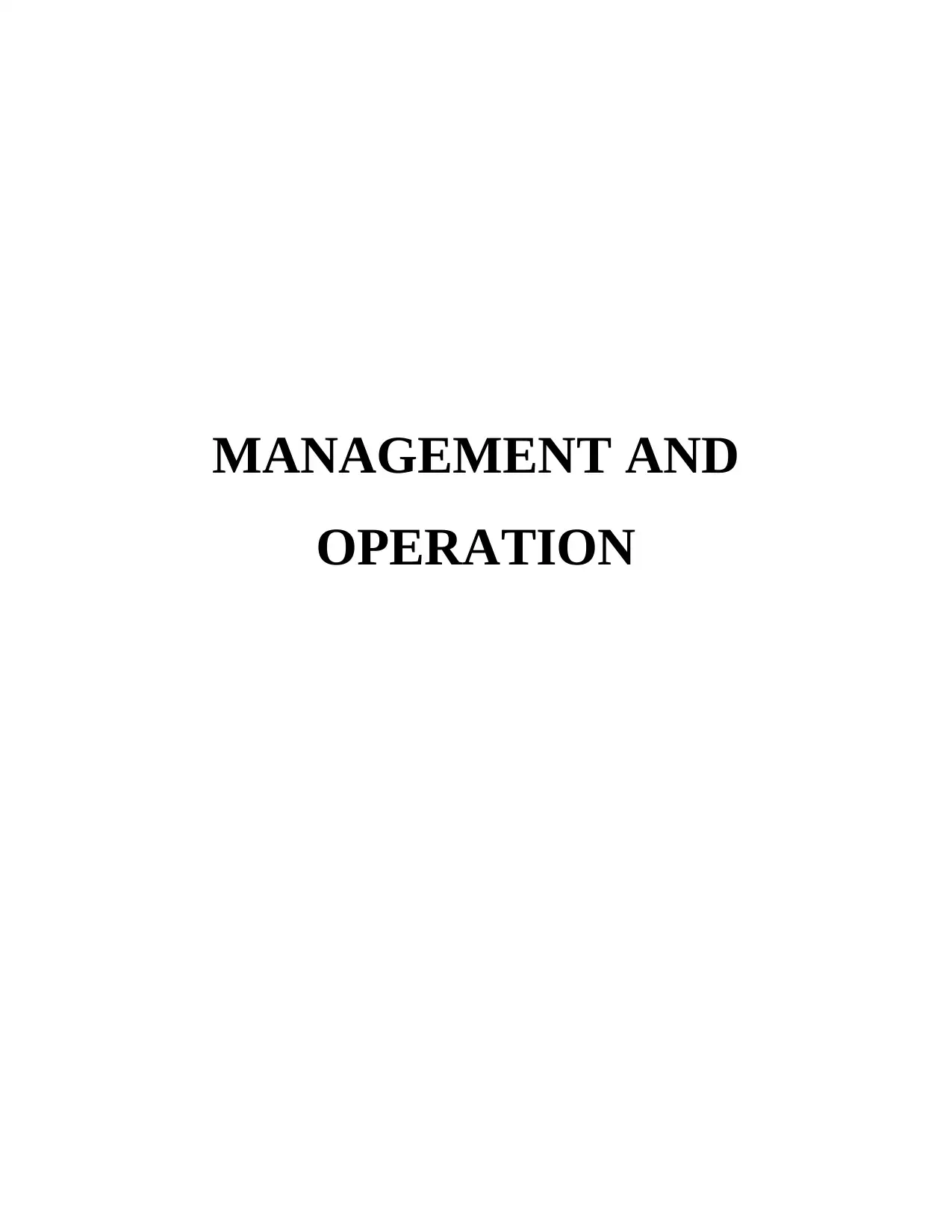
MANAGEMENT AND
OPERATION
OPERATION
Paraphrase This Document
Need a fresh take? Get an instant paraphrase of this document with our AI Paraphraser
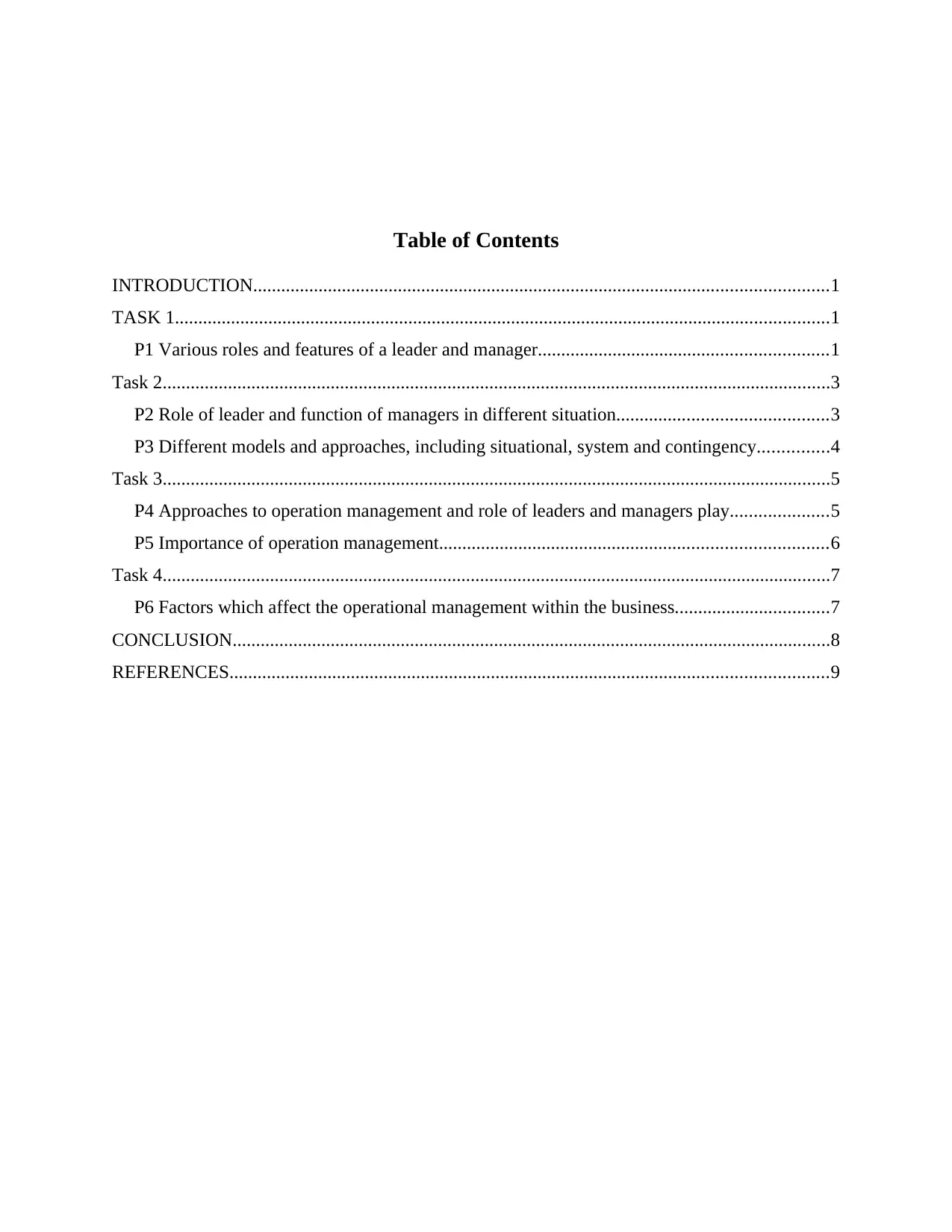
Table of Contents
INTRODUCTION...........................................................................................................................1
TASK 1............................................................................................................................................1
P1 Various roles and features of a leader and manager..............................................................1
Task 2...............................................................................................................................................3
P2 Role of leader and function of managers in different situation.............................................3
P3 Different models and approaches, including situational, system and contingency...............4
Task 3...............................................................................................................................................5
P4 Approaches to operation management and role of leaders and managers play.....................5
P5 Importance of operation management...................................................................................6
Task 4...............................................................................................................................................7
P6 Factors which affect the operational management within the business.................................7
CONCLUSION................................................................................................................................8
REFERENCES................................................................................................................................9
INTRODUCTION...........................................................................................................................1
TASK 1............................................................................................................................................1
P1 Various roles and features of a leader and manager..............................................................1
Task 2...............................................................................................................................................3
P2 Role of leader and function of managers in different situation.............................................3
P3 Different models and approaches, including situational, system and contingency...............4
Task 3...............................................................................................................................................5
P4 Approaches to operation management and role of leaders and managers play.....................5
P5 Importance of operation management...................................................................................6
Task 4...............................................................................................................................................7
P6 Factors which affect the operational management within the business.................................7
CONCLUSION................................................................................................................................8
REFERENCES................................................................................................................................9
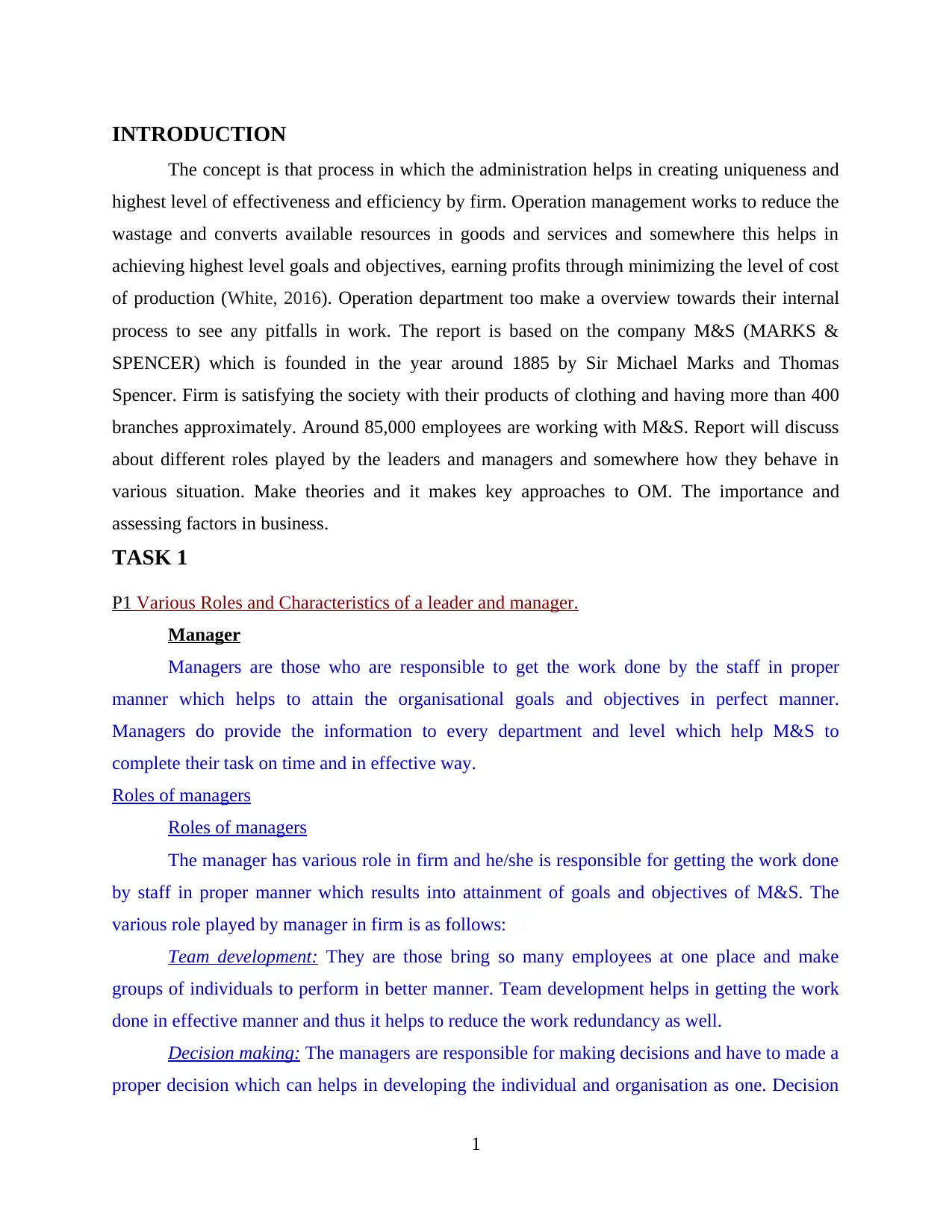
INTRODUCTION
The concept is that process in which the administration helps in creating uniqueness and
highest level of effectiveness and efficiency by firm. Operation management works to reduce the
wastage and converts available resources in goods and services and somewhere this helps in
achieving highest level goals and objectives, earning profits through minimizing the level of cost
of production (White, 2016). Operation department too make a overview towards their internal
process to see any pitfalls in work. The report is based on the company M&S (MARKS &
SPENCER) which is founded in the year around 1885 by Sir Michael Marks and Thomas
Spencer. Firm is satisfying the society with their products of clothing and having more than 400
branches approximately. Around 85,000 employees are working with M&S. Report will discuss
about different roles played by the leaders and managers and somewhere how they behave in
various situation. Make theories and it makes key approaches to OM. The importance and
assessing factors in business.
TASK 1
P1 Various Roles and Characteristics of a leader and manager.
Manager
Managers are those who are responsible to get the work done by the staff in proper
manner which helps to attain the organisational goals and objectives in perfect manner.
Managers do provide the information to every department and level which help M&S to
complete their task on time and in effective way.
Roles of managers
Roles of managers
The manager has various role in firm and he/she is responsible for getting the work done
by staff in proper manner which results into attainment of goals and objectives of M&S. The
various role played by manager in firm is as follows:
Team development: They are those bring so many employees at one place and make
groups of individuals to perform in better manner. Team development helps in getting the work
done in effective manner and thus it helps to reduce the work redundancy as well.
Decision making: The managers are responsible for making decisions and have to made a
proper decision which can helps in developing the individual and organisation as one. Decision
1
The concept is that process in which the administration helps in creating uniqueness and
highest level of effectiveness and efficiency by firm. Operation management works to reduce the
wastage and converts available resources in goods and services and somewhere this helps in
achieving highest level goals and objectives, earning profits through minimizing the level of cost
of production (White, 2016). Operation department too make a overview towards their internal
process to see any pitfalls in work. The report is based on the company M&S (MARKS &
SPENCER) which is founded in the year around 1885 by Sir Michael Marks and Thomas
Spencer. Firm is satisfying the society with their products of clothing and having more than 400
branches approximately. Around 85,000 employees are working with M&S. Report will discuss
about different roles played by the leaders and managers and somewhere how they behave in
various situation. Make theories and it makes key approaches to OM. The importance and
assessing factors in business.
TASK 1
P1 Various Roles and Characteristics of a leader and manager.
Manager
Managers are those who are responsible to get the work done by the staff in proper
manner which helps to attain the organisational goals and objectives in perfect manner.
Managers do provide the information to every department and level which help M&S to
complete their task on time and in effective way.
Roles of managers
Roles of managers
The manager has various role in firm and he/she is responsible for getting the work done
by staff in proper manner which results into attainment of goals and objectives of M&S. The
various role played by manager in firm is as follows:
Team development: They are those bring so many employees at one place and make
groups of individuals to perform in better manner. Team development helps in getting the work
done in effective manner and thus it helps to reduce the work redundancy as well.
Decision making: The managers are responsible for making decisions and have to made a
proper decision which can helps in developing the individual and organisation as one. Decision
1
⊘ This is a preview!⊘
Do you want full access?
Subscribe today to unlock all pages.

Trusted by 1+ million students worldwide
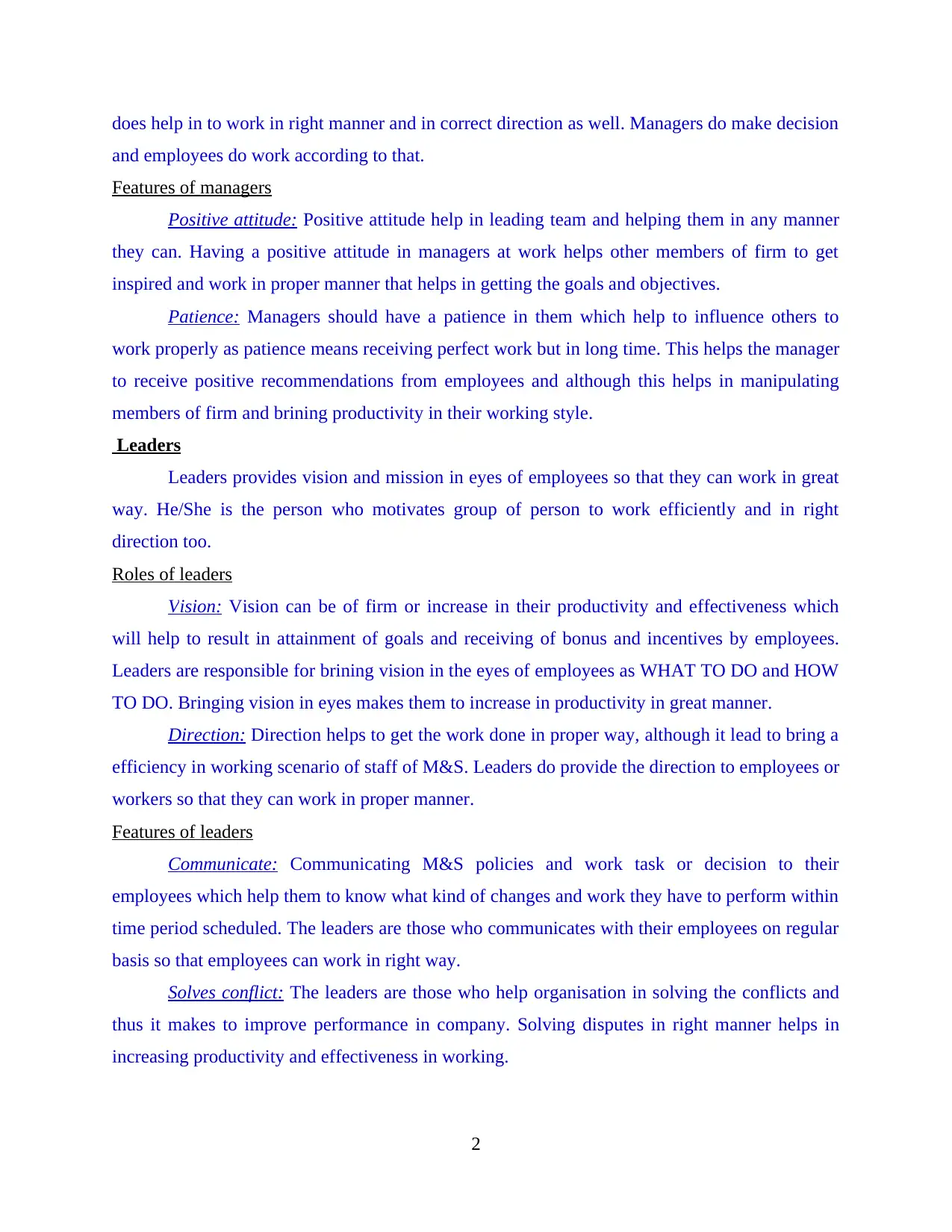
does help in to work in right manner and in correct direction as well. Managers do make decision
and employees do work according to that.
Features of managers
Positive attitude: Positive attitude help in leading team and helping them in any manner
they can. Having a positive attitude in managers at work helps other members of firm to get
inspired and work in proper manner that helps in getting the goals and objectives.
Patience: Managers should have a patience in them which help to influence others to
work properly as patience means receiving perfect work but in long time. This helps the manager
to receive positive recommendations from employees and although this helps in manipulating
members of firm and brining productivity in their working style.
Leaders
Leaders provides vision and mission in eyes of employees so that they can work in great
way. He/She is the person who motivates group of person to work efficiently and in right
direction too.
Roles of leaders
Vision: Vision can be of firm or increase in their productivity and effectiveness which
will help to result in attainment of goals and receiving of bonus and incentives by employees.
Leaders are responsible for brining vision in the eyes of employees as WHAT TO DO and HOW
TO DO. Bringing vision in eyes makes them to increase in productivity in great manner.
Direction: Direction helps to get the work done in proper way, although it lead to bring a
efficiency in working scenario of staff of M&S. Leaders do provide the direction to employees or
workers so that they can work in proper manner.
Features of leaders
Communicate: Communicating M&S policies and work task or decision to their
employees which help them to know what kind of changes and work they have to perform within
time period scheduled. The leaders are those who communicates with their employees on regular
basis so that employees can work in right way.
Solves conflict: The leaders are those who help organisation in solving the conflicts and
thus it makes to improve performance in company. Solving disputes in right manner helps in
increasing productivity and effectiveness in working.
2
and employees do work according to that.
Features of managers
Positive attitude: Positive attitude help in leading team and helping them in any manner
they can. Having a positive attitude in managers at work helps other members of firm to get
inspired and work in proper manner that helps in getting the goals and objectives.
Patience: Managers should have a patience in them which help to influence others to
work properly as patience means receiving perfect work but in long time. This helps the manager
to receive positive recommendations from employees and although this helps in manipulating
members of firm and brining productivity in their working style.
Leaders
Leaders provides vision and mission in eyes of employees so that they can work in great
way. He/She is the person who motivates group of person to work efficiently and in right
direction too.
Roles of leaders
Vision: Vision can be of firm or increase in their productivity and effectiveness which
will help to result in attainment of goals and receiving of bonus and incentives by employees.
Leaders are responsible for brining vision in the eyes of employees as WHAT TO DO and HOW
TO DO. Bringing vision in eyes makes them to increase in productivity in great manner.
Direction: Direction helps to get the work done in proper way, although it lead to bring a
efficiency in working scenario of staff of M&S. Leaders do provide the direction to employees or
workers so that they can work in proper manner.
Features of leaders
Communicate: Communicating M&S policies and work task or decision to their
employees which help them to know what kind of changes and work they have to perform within
time period scheduled. The leaders are those who communicates with their employees on regular
basis so that employees can work in right way.
Solves conflict: The leaders are those who help organisation in solving the conflicts and
thus it makes to improve performance in company. Solving disputes in right manner helps in
increasing productivity and effectiveness in working.
2
Paraphrase This Document
Need a fresh take? Get an instant paraphrase of this document with our AI Paraphraser
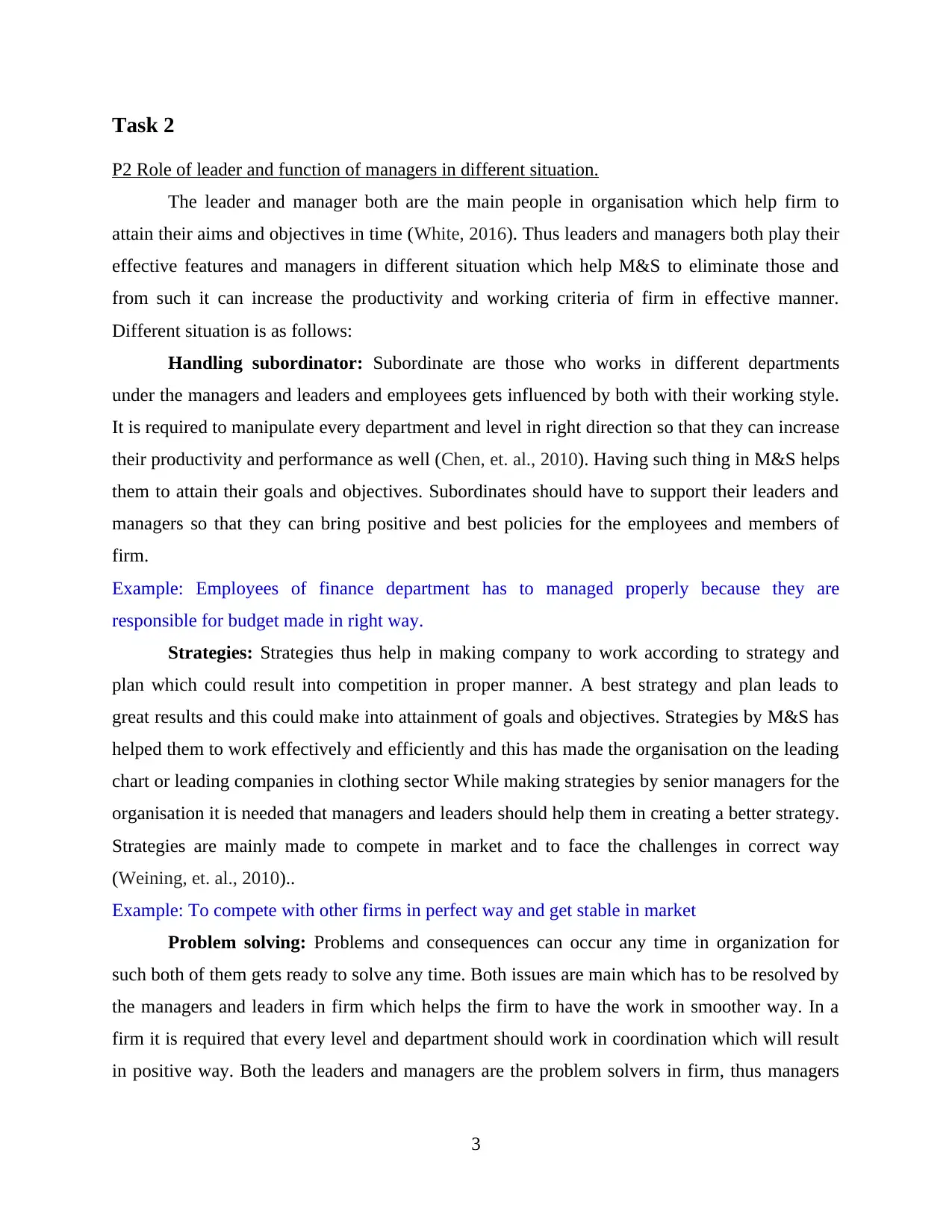
Task 2
P2 Role of leader and function of managers in different situation.
The leader and manager both are the main people in organisation which help firm to
attain their aims and objectives in time (White, 2016). Thus leaders and managers both play their
effective features and managers in different situation which help M&S to eliminate those and
from such it can increase the productivity and working criteria of firm in effective manner.
Different situation is as follows:
Handling subordinator: Subordinate are those who works in different departments
under the managers and leaders and employees gets influenced by both with their working style.
It is required to manipulate every department and level in right direction so that they can increase
their productivity and performance as well (Chen, et. al., 2010). Having such thing in M&S helps
them to attain their goals and objectives. Subordinates should have to support their leaders and
managers so that they can bring positive and best policies for the employees and members of
firm.
Example: Employees of finance department has to managed properly because they are
responsible for budget made in right way.
Strategies: Strategies thus help in making company to work according to strategy and
plan which could result into competition in proper manner. A best strategy and plan leads to
great results and this could make into attainment of goals and objectives. Strategies by M&S has
helped them to work effectively and efficiently and this has made the organisation on the leading
chart or leading companies in clothing sector While making strategies by senior managers for the
organisation it is needed that managers and leaders should help them in creating a better strategy.
Strategies are mainly made to compete in market and to face the challenges in correct way
(Weining, et. al., 2010)..
Example: To compete with other firms in perfect way and get stable in market
Problem solving: Problems and consequences can occur any time in organization for
such both of them gets ready to solve any time. Both issues are main which has to be resolved by
the managers and leaders in firm which helps the firm to have the work in smoother way. In a
firm it is required that every level and department should work in coordination which will result
in positive way. Both the leaders and managers are the problem solvers in firm, thus managers
3
P2 Role of leader and function of managers in different situation.
The leader and manager both are the main people in organisation which help firm to
attain their aims and objectives in time (White, 2016). Thus leaders and managers both play their
effective features and managers in different situation which help M&S to eliminate those and
from such it can increase the productivity and working criteria of firm in effective manner.
Different situation is as follows:
Handling subordinator: Subordinate are those who works in different departments
under the managers and leaders and employees gets influenced by both with their working style.
It is required to manipulate every department and level in right direction so that they can increase
their productivity and performance as well (Chen, et. al., 2010). Having such thing in M&S helps
them to attain their goals and objectives. Subordinates should have to support their leaders and
managers so that they can bring positive and best policies for the employees and members of
firm.
Example: Employees of finance department has to managed properly because they are
responsible for budget made in right way.
Strategies: Strategies thus help in making company to work according to strategy and
plan which could result into competition in proper manner. A best strategy and plan leads to
great results and this could make into attainment of goals and objectives. Strategies by M&S has
helped them to work effectively and efficiently and this has made the organisation on the leading
chart or leading companies in clothing sector While making strategies by senior managers for the
organisation it is needed that managers and leaders should help them in creating a better strategy.
Strategies are mainly made to compete in market and to face the challenges in correct way
(Weining, et. al., 2010)..
Example: To compete with other firms in perfect way and get stable in market
Problem solving: Problems and consequences can occur any time in organization for
such both of them gets ready to solve any time. Both issues are main which has to be resolved by
the managers and leaders in firm which helps the firm to have the work in smoother way. In a
firm it is required that every level and department should work in coordination which will result
in positive way. Both the leaders and managers are the problem solvers in firm, thus managers
3
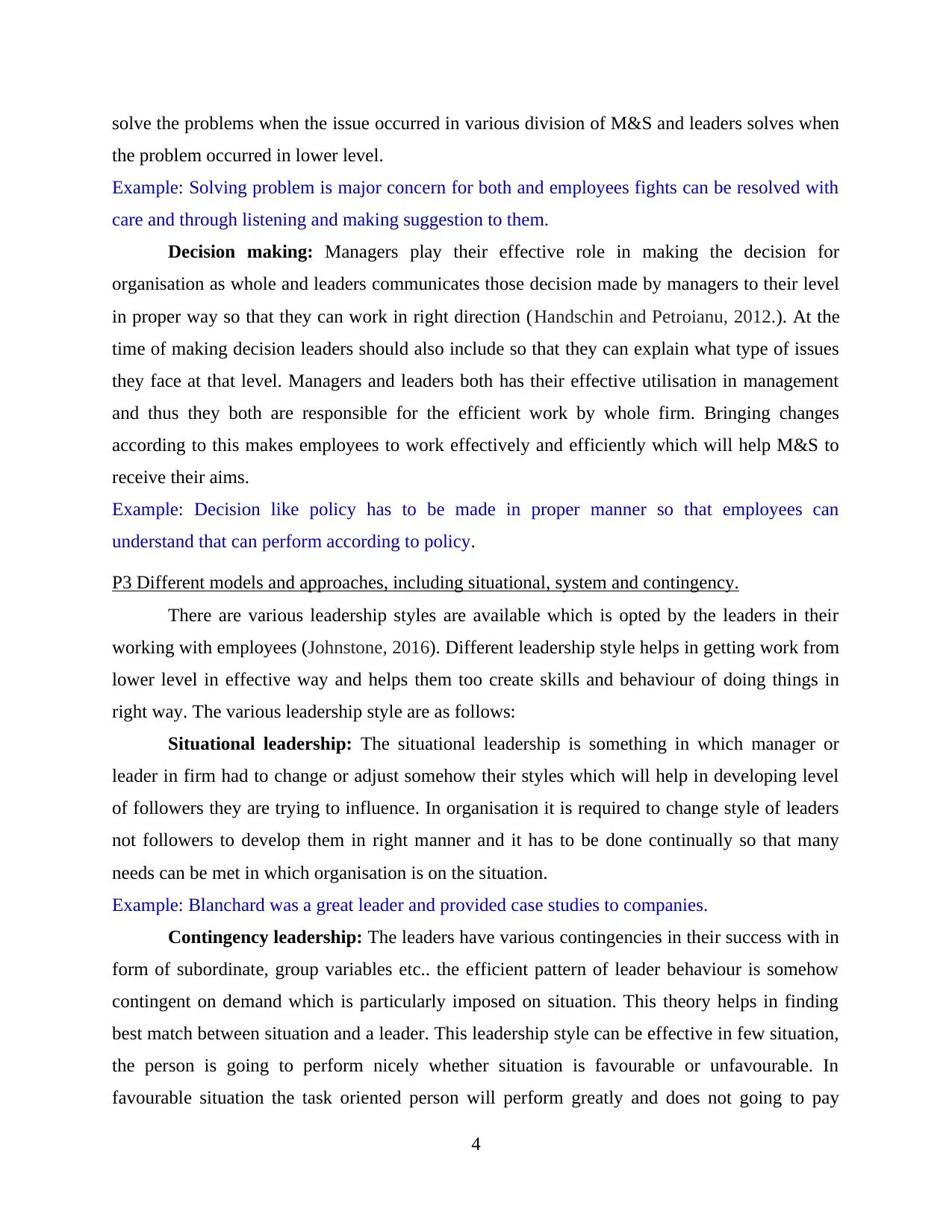
solve the problems when the issue occurred in various division of M&S and leaders solves when
the problem occurred in lower level.
Example: Solving problem is major concern for both and employees fights can be resolved with
care and through listening and making suggestion to them.
Decision making: Managers play their effective role in making the decision for
organisation as whole and leaders communicates those decision made by managers to their level
in proper way so that they can work in right direction (Handschin and Petroianu, 2012.). At the
time of making decision leaders should also include so that they can explain what type of issues
they face at that level. Managers and leaders both has their effective utilisation in management
and thus they both are responsible for the efficient work by whole firm. Bringing changes
according to this makes employees to work effectively and efficiently which will help M&S to
receive their aims.
Example: Decision like policy has to be made in proper manner so that employees can
understand that can perform according to policy.
P3 Different models and approaches, including situational, system and contingency.
There are various leadership styles are available which is opted by the leaders in their
working with employees (Johnstone, 2016). Different leadership style helps in getting work from
lower level in effective way and helps them too create skills and behaviour of doing things in
right way. The various leadership style are as follows:
Situational leadership: The situational leadership is something in which manager or
leader in firm had to change or adjust somehow their styles which will help in developing level
of followers they are trying to influence. In organisation it is required to change style of leaders
not followers to develop them in right manner and it has to be done continually so that many
needs can be met in which organisation is on the situation.
Example: Blanchard was a great leader and provided case studies to companies.
Contingency leadership: The leaders have various contingencies in their success with in
form of subordinate, group variables etc.. the efficient pattern of leader behaviour is somehow
contingent on demand which is particularly imposed on situation. This theory helps in finding
best match between situation and a leader. This leadership style can be effective in few situation,
the person is going to perform nicely whether situation is favourable or unfavourable. In
favourable situation the task oriented person will perform greatly and does not going to pay
4
the problem occurred in lower level.
Example: Solving problem is major concern for both and employees fights can be resolved with
care and through listening and making suggestion to them.
Decision making: Managers play their effective role in making the decision for
organisation as whole and leaders communicates those decision made by managers to their level
in proper way so that they can work in right direction (Handschin and Petroianu, 2012.). At the
time of making decision leaders should also include so that they can explain what type of issues
they face at that level. Managers and leaders both has their effective utilisation in management
and thus they both are responsible for the efficient work by whole firm. Bringing changes
according to this makes employees to work effectively and efficiently which will help M&S to
receive their aims.
Example: Decision like policy has to be made in proper manner so that employees can
understand that can perform according to policy.
P3 Different models and approaches, including situational, system and contingency.
There are various leadership styles are available which is opted by the leaders in their
working with employees (Johnstone, 2016). Different leadership style helps in getting work from
lower level in effective way and helps them too create skills and behaviour of doing things in
right way. The various leadership style are as follows:
Situational leadership: The situational leadership is something in which manager or
leader in firm had to change or adjust somehow their styles which will help in developing level
of followers they are trying to influence. In organisation it is required to change style of leaders
not followers to develop them in right manner and it has to be done continually so that many
needs can be met in which organisation is on the situation.
Example: Blanchard was a great leader and provided case studies to companies.
Contingency leadership: The leaders have various contingencies in their success with in
form of subordinate, group variables etc.. the efficient pattern of leader behaviour is somehow
contingent on demand which is particularly imposed on situation. This theory helps in finding
best match between situation and a leader. This leadership style can be effective in few situation,
the person is going to perform nicely whether situation is favourable or unfavourable. In
favourable situation the task oriented person will perform greatly and does not going to pay
4
⊘ This is a preview!⊘
Do you want full access?
Subscribe today to unlock all pages.

Trusted by 1+ million students worldwide
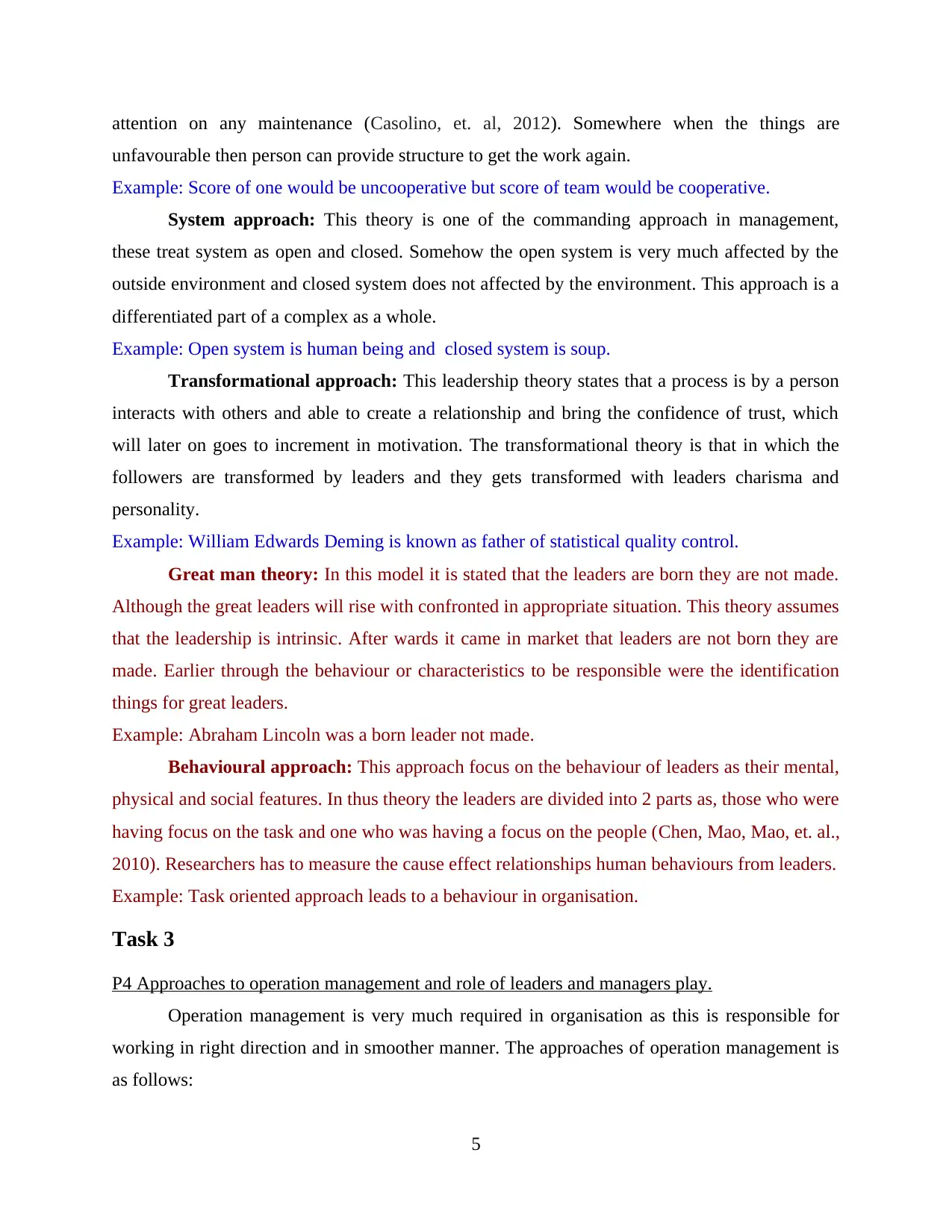
attention on any maintenance (Casolino, et. al, 2012). Somewhere when the things are
unfavourable then person can provide structure to get the work again.
Example: Score of one would be uncooperative but score of team would be cooperative.
System approach: This theory is one of the commanding approach in management,
these treat system as open and closed. Somehow the open system is very much affected by the
outside environment and closed system does not affected by the environment. This approach is a
differentiated part of a complex as a whole.
Example: Open system is human being and closed system is soup.
Transformational approach: This leadership theory states that a process is by a person
interacts with others and able to create a relationship and bring the confidence of trust, which
will later on goes to increment in motivation. The transformational theory is that in which the
followers are transformed by leaders and they gets transformed with leaders charisma and
personality.
Example: William Edwards Deming is known as father of statistical quality control.
Great man theory: In this model it is stated that the leaders are born they are not made.
Although the great leaders will rise with confronted in appropriate situation. This theory assumes
that the leadership is intrinsic. After wards it came in market that leaders are not born they are
made. Earlier through the behaviour or characteristics to be responsible were the identification
things for great leaders.
Example: Abraham Lincoln was a born leader not made.
Behavioural approach: This approach focus on the behaviour of leaders as their mental,
physical and social features. In thus theory the leaders are divided into 2 parts as, those who were
having focus on the task and one who was having a focus on the people (Chen, Mao, Mao, et. al.,
2010). Researchers has to measure the cause effect relationships human behaviours from leaders.
Example: Task oriented approach leads to a behaviour in organisation.
Task 3
P4 Approaches to operation management and role of leaders and managers play.
Operation management is very much required in organisation as this is responsible for
working in right direction and in smoother manner. The approaches of operation management is
as follows:
5
unfavourable then person can provide structure to get the work again.
Example: Score of one would be uncooperative but score of team would be cooperative.
System approach: This theory is one of the commanding approach in management,
these treat system as open and closed. Somehow the open system is very much affected by the
outside environment and closed system does not affected by the environment. This approach is a
differentiated part of a complex as a whole.
Example: Open system is human being and closed system is soup.
Transformational approach: This leadership theory states that a process is by a person
interacts with others and able to create a relationship and bring the confidence of trust, which
will later on goes to increment in motivation. The transformational theory is that in which the
followers are transformed by leaders and they gets transformed with leaders charisma and
personality.
Example: William Edwards Deming is known as father of statistical quality control.
Great man theory: In this model it is stated that the leaders are born they are not made.
Although the great leaders will rise with confronted in appropriate situation. This theory assumes
that the leadership is intrinsic. After wards it came in market that leaders are not born they are
made. Earlier through the behaviour or characteristics to be responsible were the identification
things for great leaders.
Example: Abraham Lincoln was a born leader not made.
Behavioural approach: This approach focus on the behaviour of leaders as their mental,
physical and social features. In thus theory the leaders are divided into 2 parts as, those who were
having focus on the task and one who was having a focus on the people (Chen, Mao, Mao, et. al.,
2010). Researchers has to measure the cause effect relationships human behaviours from leaders.
Example: Task oriented approach leads to a behaviour in organisation.
Task 3
P4 Approaches to operation management and role of leaders and managers play.
Operation management is very much required in organisation as this is responsible for
working in right direction and in smoother manner. The approaches of operation management is
as follows:
5
Paraphrase This Document
Need a fresh take? Get an instant paraphrase of this document with our AI Paraphraser
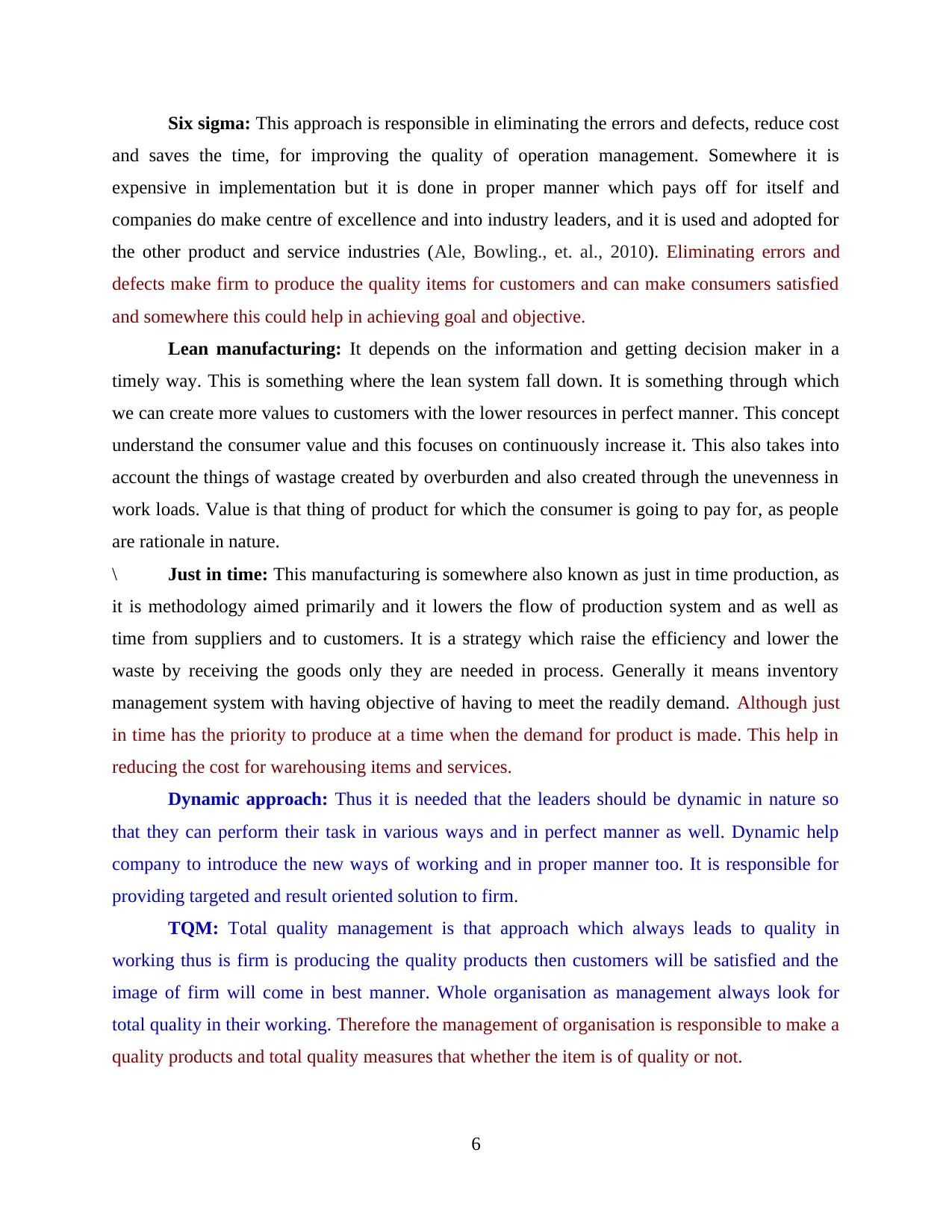
Six sigma: This approach is responsible in eliminating the errors and defects, reduce cost
and saves the time, for improving the quality of operation management. Somewhere it is
expensive in implementation but it is done in proper manner which pays off for itself and
companies do make centre of excellence and into industry leaders, and it is used and adopted for
the other product and service industries (Ale, Bowling., et. al., 2010). Eliminating errors and
defects make firm to produce the quality items for customers and can make consumers satisfied
and somewhere this could help in achieving goal and objective.
Lean manufacturing: It depends on the information and getting decision maker in a
timely way. This is something where the lean system fall down. It is something through which
we can create more values to customers with the lower resources in perfect manner. This concept
understand the consumer value and this focuses on continuously increase it. This also takes into
account the things of wastage created by overburden and also created through the unevenness in
work loads. Value is that thing of product for which the consumer is going to pay for, as people
are rationale in nature.
\ Just in time: This manufacturing is somewhere also known as just in time production, as
it is methodology aimed primarily and it lowers the flow of production system and as well as
time from suppliers and to customers. It is a strategy which raise the efficiency and lower the
waste by receiving the goods only they are needed in process. Generally it means inventory
management system with having objective of having to meet the readily demand. Although just
in time has the priority to produce at a time when the demand for product is made. This help in
reducing the cost for warehousing items and services.
Dynamic approach: Thus it is needed that the leaders should be dynamic in nature so
that they can perform their task in various ways and in perfect manner as well. Dynamic help
company to introduce the new ways of working and in proper manner too. It is responsible for
providing targeted and result oriented solution to firm.
TQM: Total quality management is that approach which always leads to quality in
working thus is firm is producing the quality products then customers will be satisfied and the
image of firm will come in best manner. Whole organisation as management always look for
total quality in their working. Therefore the management of organisation is responsible to make a
quality products and total quality measures that whether the item is of quality or not.
6
and saves the time, for improving the quality of operation management. Somewhere it is
expensive in implementation but it is done in proper manner which pays off for itself and
companies do make centre of excellence and into industry leaders, and it is used and adopted for
the other product and service industries (Ale, Bowling., et. al., 2010). Eliminating errors and
defects make firm to produce the quality items for customers and can make consumers satisfied
and somewhere this could help in achieving goal and objective.
Lean manufacturing: It depends on the information and getting decision maker in a
timely way. This is something where the lean system fall down. It is something through which
we can create more values to customers with the lower resources in perfect manner. This concept
understand the consumer value and this focuses on continuously increase it. This also takes into
account the things of wastage created by overburden and also created through the unevenness in
work loads. Value is that thing of product for which the consumer is going to pay for, as people
are rationale in nature.
\ Just in time: This manufacturing is somewhere also known as just in time production, as
it is methodology aimed primarily and it lowers the flow of production system and as well as
time from suppliers and to customers. It is a strategy which raise the efficiency and lower the
waste by receiving the goods only they are needed in process. Generally it means inventory
management system with having objective of having to meet the readily demand. Although just
in time has the priority to produce at a time when the demand for product is made. This help in
reducing the cost for warehousing items and services.
Dynamic approach: Thus it is needed that the leaders should be dynamic in nature so
that they can perform their task in various ways and in perfect manner as well. Dynamic help
company to introduce the new ways of working and in proper manner too. It is responsible for
providing targeted and result oriented solution to firm.
TQM: Total quality management is that approach which always leads to quality in
working thus is firm is producing the quality products then customers will be satisfied and the
image of firm will come in best manner. Whole organisation as management always look for
total quality in their working. Therefore the management of organisation is responsible to make a
quality products and total quality measures that whether the item is of quality or not.
6
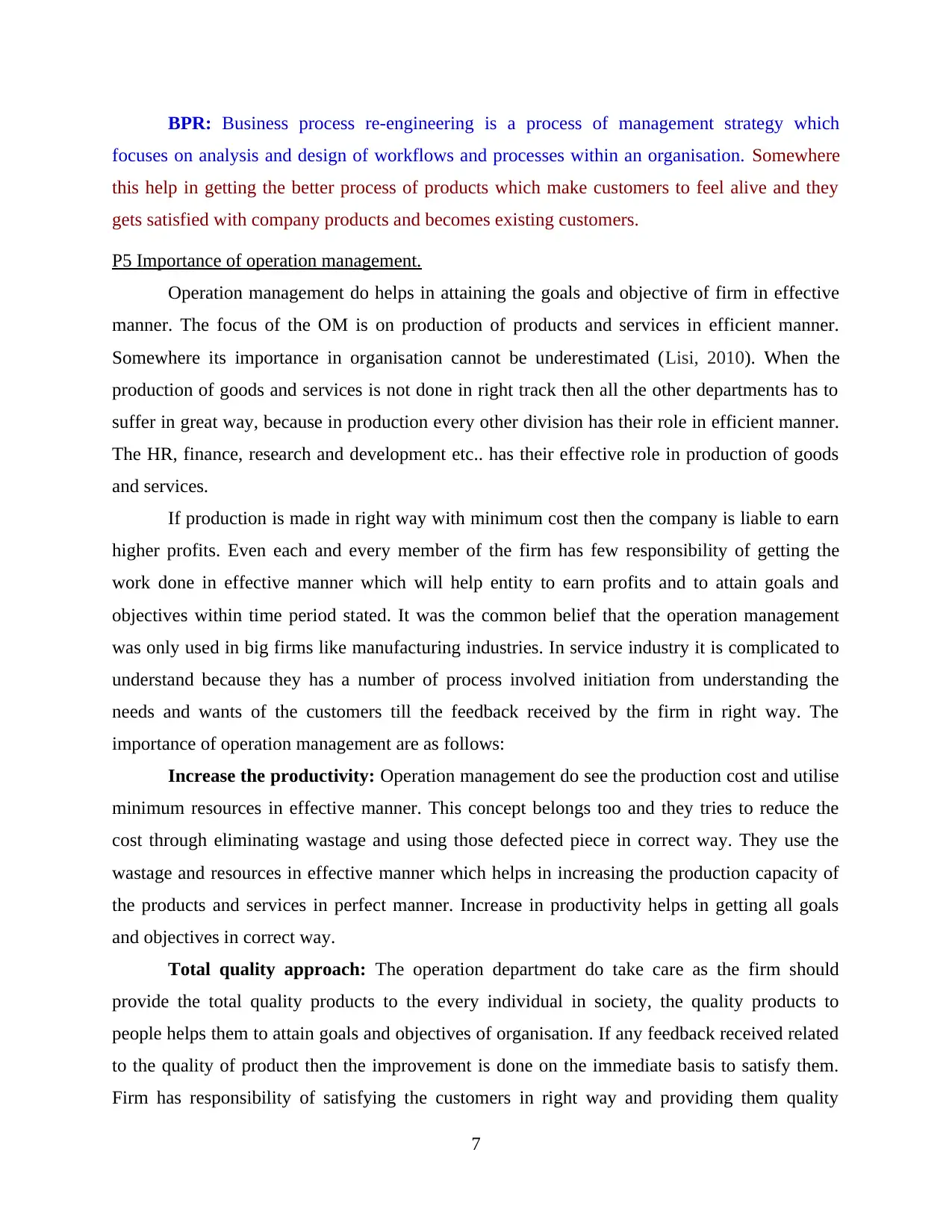
BPR: Business process re-engineering is a process of management strategy which
focuses on analysis and design of workflows and processes within an organisation. Somewhere
this help in getting the better process of products which make customers to feel alive and they
gets satisfied with company products and becomes existing customers.
P5 Importance of operation management.
Operation management do helps in attaining the goals and objective of firm in effective
manner. The focus of the OM is on production of products and services in efficient manner.
Somewhere its importance in organisation cannot be underestimated (Lisi, 2010). When the
production of goods and services is not done in right track then all the other departments has to
suffer in great way, because in production every other division has their role in efficient manner.
The HR, finance, research and development etc.. has their effective role in production of goods
and services.
If production is made in right way with minimum cost then the company is liable to earn
higher profits. Even each and every member of the firm has few responsibility of getting the
work done in effective manner which will help entity to earn profits and to attain goals and
objectives within time period stated. It was the common belief that the operation management
was only used in big firms like manufacturing industries. In service industry it is complicated to
understand because they has a number of process involved initiation from understanding the
needs and wants of the customers till the feedback received by the firm in right way. The
importance of operation management are as follows:
Increase the productivity: Operation management do see the production cost and utilise
minimum resources in effective manner. This concept belongs too and they tries to reduce the
cost through eliminating wastage and using those defected piece in correct way. They use the
wastage and resources in effective manner which helps in increasing the production capacity of
the products and services in perfect manner. Increase in productivity helps in getting all goals
and objectives in correct way.
Total quality approach: The operation department do take care as the firm should
provide the total quality products to the every individual in society, the quality products to
people helps them to attain goals and objectives of organisation. If any feedback received related
to the quality of product then the improvement is done on the immediate basis to satisfy them.
Firm has responsibility of satisfying the customers in right way and providing them quality
7
focuses on analysis and design of workflows and processes within an organisation. Somewhere
this help in getting the better process of products which make customers to feel alive and they
gets satisfied with company products and becomes existing customers.
P5 Importance of operation management.
Operation management do helps in attaining the goals and objective of firm in effective
manner. The focus of the OM is on production of products and services in efficient manner.
Somewhere its importance in organisation cannot be underestimated (Lisi, 2010). When the
production of goods and services is not done in right track then all the other departments has to
suffer in great way, because in production every other division has their role in efficient manner.
The HR, finance, research and development etc.. has their effective role in production of goods
and services.
If production is made in right way with minimum cost then the company is liable to earn
higher profits. Even each and every member of the firm has few responsibility of getting the
work done in effective manner which will help entity to earn profits and to attain goals and
objectives within time period stated. It was the common belief that the operation management
was only used in big firms like manufacturing industries. In service industry it is complicated to
understand because they has a number of process involved initiation from understanding the
needs and wants of the customers till the feedback received by the firm in right way. The
importance of operation management are as follows:
Increase the productivity: Operation management do see the production cost and utilise
minimum resources in effective manner. This concept belongs too and they tries to reduce the
cost through eliminating wastage and using those defected piece in correct way. They use the
wastage and resources in effective manner which helps in increasing the production capacity of
the products and services in perfect manner. Increase in productivity helps in getting all goals
and objectives in correct way.
Total quality approach: The operation department do take care as the firm should
provide the total quality products to the every individual in society, the quality products to
people helps them to attain goals and objectives of organisation. If any feedback received related
to the quality of product then the improvement is done on the immediate basis to satisfy them.
Firm has responsibility of satisfying the customers in right way and providing them quality
7
⊘ This is a preview!⊘
Do you want full access?
Subscribe today to unlock all pages.

Trusted by 1+ million students worldwide
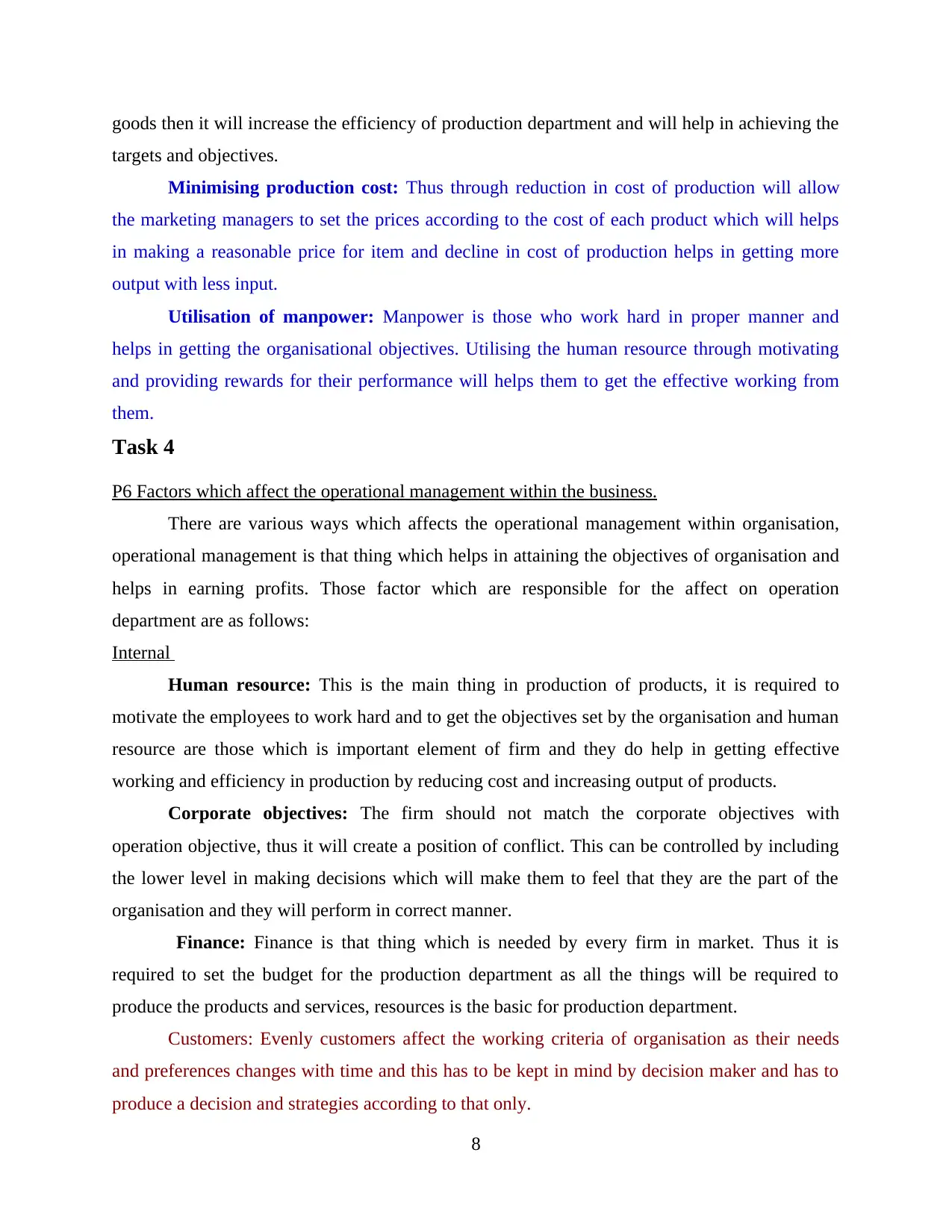
goods then it will increase the efficiency of production department and will help in achieving the
targets and objectives.
Minimising production cost: Thus through reduction in cost of production will allow
the marketing managers to set the prices according to the cost of each product which will helps
in making a reasonable price for item and decline in cost of production helps in getting more
output with less input.
Utilisation of manpower: Manpower is those who work hard in proper manner and
helps in getting the organisational objectives. Utilising the human resource through motivating
and providing rewards for their performance will helps them to get the effective working from
them.
Task 4
P6 Factors which affect the operational management within the business.
There are various ways which affects the operational management within organisation,
operational management is that thing which helps in attaining the objectives of organisation and
helps in earning profits. Those factor which are responsible for the affect on operation
department are as follows:
Internal
Human resource: This is the main thing in production of products, it is required to
motivate the employees to work hard and to get the objectives set by the organisation and human
resource are those which is important element of firm and they do help in getting effective
working and efficiency in production by reducing cost and increasing output of products.
Corporate objectives: The firm should not match the corporate objectives with
operation objective, thus it will create a position of conflict. This can be controlled by including
the lower level in making decisions which will make them to feel that they are the part of the
organisation and they will perform in correct manner.
Finance: Finance is that thing which is needed by every firm in market. Thus it is
required to set the budget for the production department as all the things will be required to
produce the products and services, resources is the basic for production department.
Customers: Evenly customers affect the working criteria of organisation as their needs
and preferences changes with time and this has to be kept in mind by decision maker and has to
produce a decision and strategies according to that only.
8
targets and objectives.
Minimising production cost: Thus through reduction in cost of production will allow
the marketing managers to set the prices according to the cost of each product which will helps
in making a reasonable price for item and decline in cost of production helps in getting more
output with less input.
Utilisation of manpower: Manpower is those who work hard in proper manner and
helps in getting the organisational objectives. Utilising the human resource through motivating
and providing rewards for their performance will helps them to get the effective working from
them.
Task 4
P6 Factors which affect the operational management within the business.
There are various ways which affects the operational management within organisation,
operational management is that thing which helps in attaining the objectives of organisation and
helps in earning profits. Those factor which are responsible for the affect on operation
department are as follows:
Internal
Human resource: This is the main thing in production of products, it is required to
motivate the employees to work hard and to get the objectives set by the organisation and human
resource are those which is important element of firm and they do help in getting effective
working and efficiency in production by reducing cost and increasing output of products.
Corporate objectives: The firm should not match the corporate objectives with
operation objective, thus it will create a position of conflict. This can be controlled by including
the lower level in making decisions which will make them to feel that they are the part of the
organisation and they will perform in correct manner.
Finance: Finance is that thing which is needed by every firm in market. Thus it is
required to set the budget for the production department as all the things will be required to
produce the products and services, resources is the basic for production department.
Customers: Evenly customers affect the working criteria of organisation as their needs
and preferences changes with time and this has to be kept in mind by decision maker and has to
produce a decision and strategies according to that only.
8
Paraphrase This Document
Need a fresh take? Get an instant paraphrase of this document with our AI Paraphraser
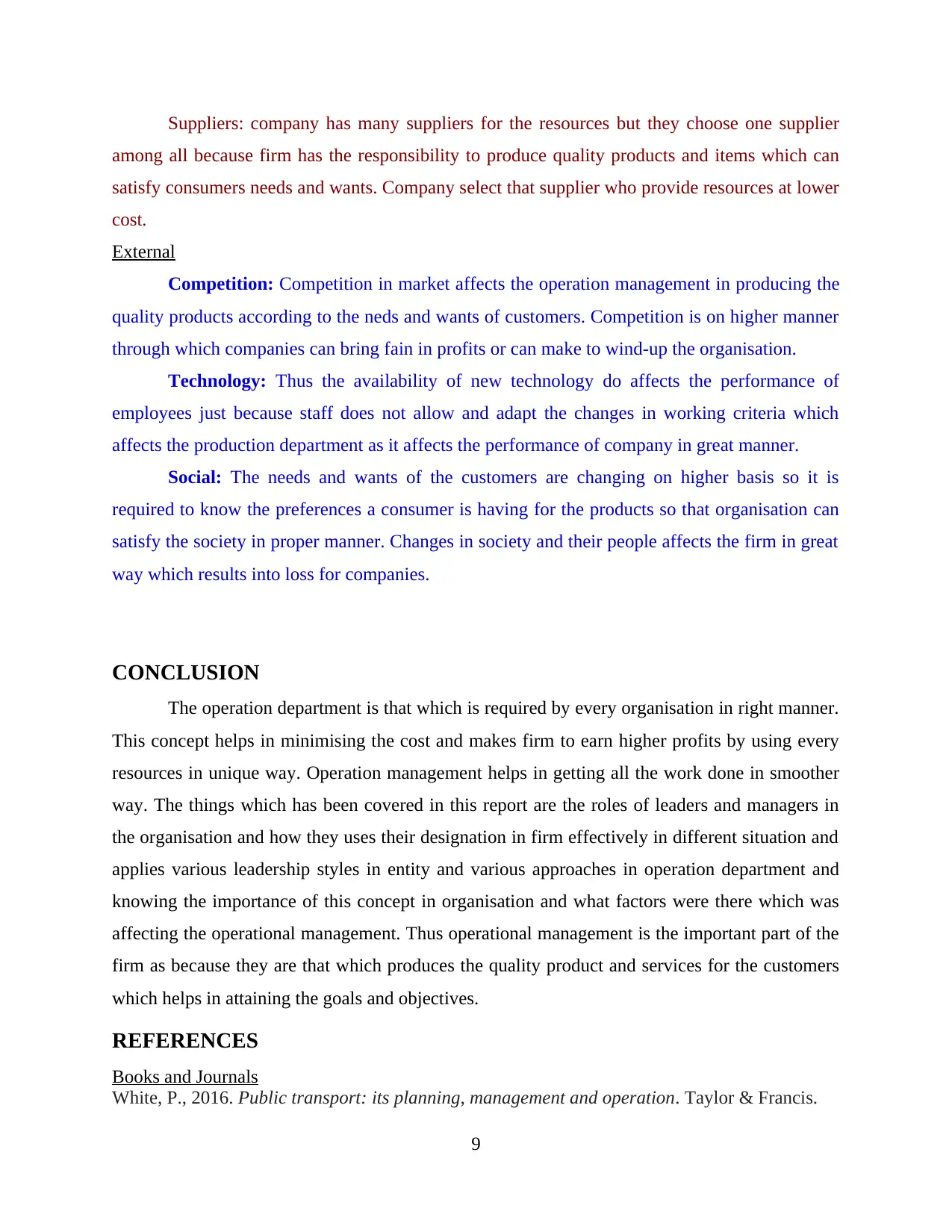
Suppliers: company has many suppliers for the resources but they choose one supplier
among all because firm has the responsibility to produce quality products and items which can
satisfy consumers needs and wants. Company select that supplier who provide resources at lower
cost.
External
Competition: Competition in market affects the operation management in producing the
quality products according to the neds and wants of customers. Competition is on higher manner
through which companies can bring fain in profits or can make to wind-up the organisation.
Technology: Thus the availability of new technology do affects the performance of
employees just because staff does not allow and adapt the changes in working criteria which
affects the production department as it affects the performance of company in great manner.
Social: The needs and wants of the customers are changing on higher basis so it is
required to know the preferences a consumer is having for the products so that organisation can
satisfy the society in proper manner. Changes in society and their people affects the firm in great
way which results into loss for companies.
CONCLUSION
The operation department is that which is required by every organisation in right manner.
This concept helps in minimising the cost and makes firm to earn higher profits by using every
resources in unique way. Operation management helps in getting all the work done in smoother
way. The things which has been covered in this report are the roles of leaders and managers in
the organisation and how they uses their designation in firm effectively in different situation and
applies various leadership styles in entity and various approaches in operation department and
knowing the importance of this concept in organisation and what factors were there which was
affecting the operational management. Thus operational management is the important part of the
firm as because they are that which produces the quality product and services for the customers
which helps in attaining the goals and objectives.
REFERENCES
Books and Journals
White, P., 2016. Public transport: its planning, management and operation. Taylor & Francis.
9
among all because firm has the responsibility to produce quality products and items which can
satisfy consumers needs and wants. Company select that supplier who provide resources at lower
cost.
External
Competition: Competition in market affects the operation management in producing the
quality products according to the neds and wants of customers. Competition is on higher manner
through which companies can bring fain in profits or can make to wind-up the organisation.
Technology: Thus the availability of new technology do affects the performance of
employees just because staff does not allow and adapt the changes in working criteria which
affects the production department as it affects the performance of company in great manner.
Social: The needs and wants of the customers are changing on higher basis so it is
required to know the preferences a consumer is having for the products so that organisation can
satisfy the society in proper manner. Changes in society and their people affects the firm in great
way which results into loss for companies.
CONCLUSION
The operation department is that which is required by every organisation in right manner.
This concept helps in minimising the cost and makes firm to earn higher profits by using every
resources in unique way. Operation management helps in getting all the work done in smoother
way. The things which has been covered in this report are the roles of leaders and managers in
the organisation and how they uses their designation in firm effectively in different situation and
applies various leadership styles in entity and various approaches in operation department and
knowing the importance of this concept in organisation and what factors were there which was
affecting the operational management. Thus operational management is the important part of the
firm as because they are that which produces the quality product and services for the customers
which helps in attaining the goals and objectives.
REFERENCES
Books and Journals
White, P., 2016. Public transport: its planning, management and operation. Taylor & Francis.
9
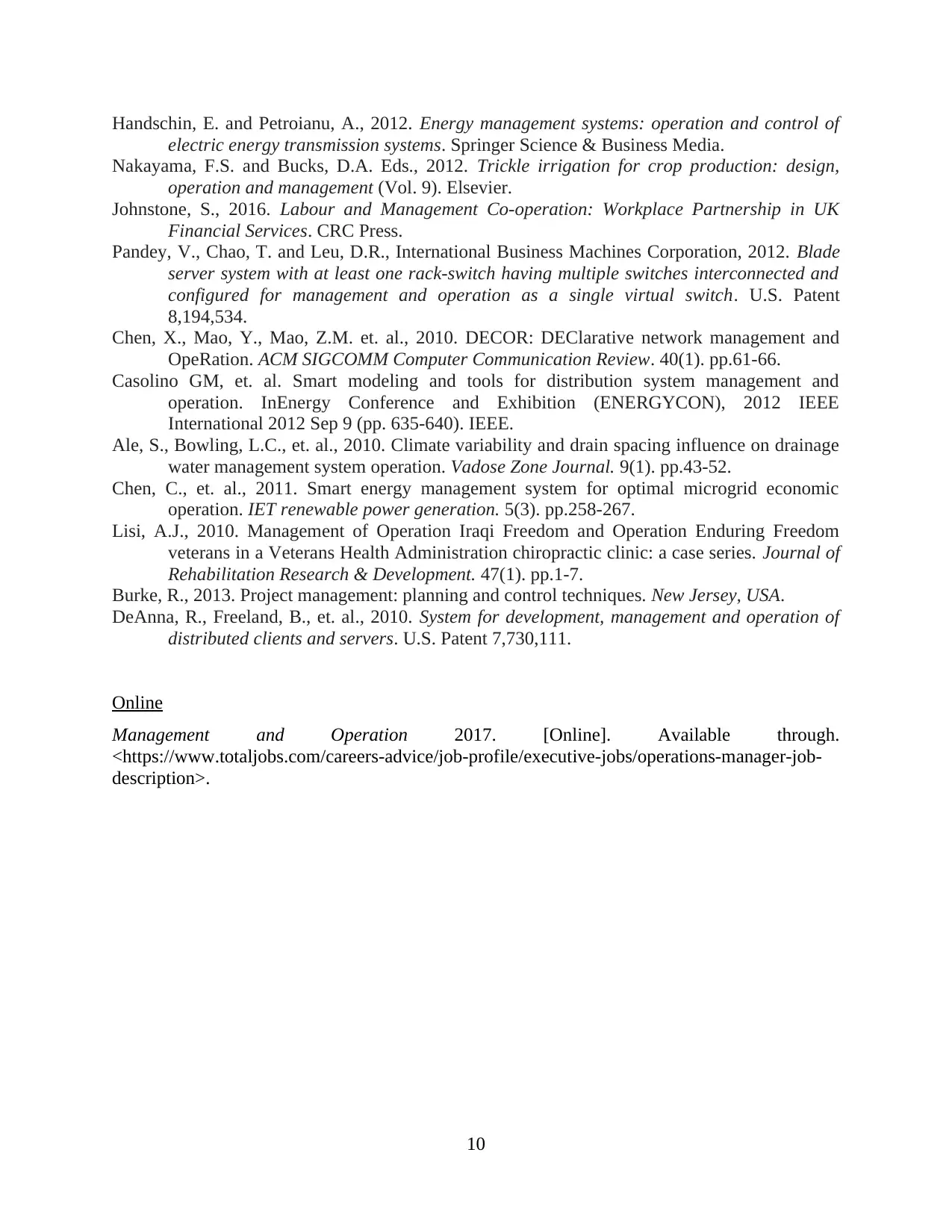
Handschin, E. and Petroianu, A., 2012. Energy management systems: operation and control of
electric energy transmission systems. Springer Science & Business Media.
Nakayama, F.S. and Bucks, D.A. Eds., 2012. Trickle irrigation for crop production: design,
operation and management (Vol. 9). Elsevier.
Johnstone, S., 2016. Labour and Management Co-operation: Workplace Partnership in UK
Financial Services. CRC Press.
Pandey, V., Chao, T. and Leu, D.R., International Business Machines Corporation, 2012. Blade
server system with at least one rack-switch having multiple switches interconnected and
configured for management and operation as a single virtual switch. U.S. Patent
8,194,534.
Chen, X., Mao, Y., Mao, Z.M. et. al., 2010. DECOR: DEClarative network management and
OpeRation. ACM SIGCOMM Computer Communication Review. 40(1). pp.61-66.
Casolino GM, et. al. Smart modeling and tools for distribution system management and
operation. InEnergy Conference and Exhibition (ENERGYCON), 2012 IEEE
International 2012 Sep 9 (pp. 635-640). IEEE.
Ale, S., Bowling, L.C., et. al., 2010. Climate variability and drain spacing influence on drainage
water management system operation. Vadose Zone Journal. 9(1). pp.43-52.
Chen, C., et. al., 2011. Smart energy management system for optimal microgrid economic
operation. IET renewable power generation. 5(3). pp.258-267.
Lisi, A.J., 2010. Management of Operation Iraqi Freedom and Operation Enduring Freedom
veterans in a Veterans Health Administration chiropractic clinic: a case series. Journal of
Rehabilitation Research & Development. 47(1). pp.1-7.
Burke, R., 2013. Project management: planning and control techniques. New Jersey, USA.
DeAnna, R., Freeland, B., et. al., 2010. System for development, management and operation of
distributed clients and servers. U.S. Patent 7,730,111.
Online
Management and Operation 2017. [Online]. Available through.
<https://www.totaljobs.com/careers-advice/job-profile/executive-jobs/operations-manager-job-
description>.
10
electric energy transmission systems. Springer Science & Business Media.
Nakayama, F.S. and Bucks, D.A. Eds., 2012. Trickle irrigation for crop production: design,
operation and management (Vol. 9). Elsevier.
Johnstone, S., 2016. Labour and Management Co-operation: Workplace Partnership in UK
Financial Services. CRC Press.
Pandey, V., Chao, T. and Leu, D.R., International Business Machines Corporation, 2012. Blade
server system with at least one rack-switch having multiple switches interconnected and
configured for management and operation as a single virtual switch. U.S. Patent
8,194,534.
Chen, X., Mao, Y., Mao, Z.M. et. al., 2010. DECOR: DEClarative network management and
OpeRation. ACM SIGCOMM Computer Communication Review. 40(1). pp.61-66.
Casolino GM, et. al. Smart modeling and tools for distribution system management and
operation. InEnergy Conference and Exhibition (ENERGYCON), 2012 IEEE
International 2012 Sep 9 (pp. 635-640). IEEE.
Ale, S., Bowling, L.C., et. al., 2010. Climate variability and drain spacing influence on drainage
water management system operation. Vadose Zone Journal. 9(1). pp.43-52.
Chen, C., et. al., 2011. Smart energy management system for optimal microgrid economic
operation. IET renewable power generation. 5(3). pp.258-267.
Lisi, A.J., 2010. Management of Operation Iraqi Freedom and Operation Enduring Freedom
veterans in a Veterans Health Administration chiropractic clinic: a case series. Journal of
Rehabilitation Research & Development. 47(1). pp.1-7.
Burke, R., 2013. Project management: planning and control techniques. New Jersey, USA.
DeAnna, R., Freeland, B., et. al., 2010. System for development, management and operation of
distributed clients and servers. U.S. Patent 7,730,111.
Online
Management and Operation 2017. [Online]. Available through.
<https://www.totaljobs.com/careers-advice/job-profile/executive-jobs/operations-manager-job-
description>.
10
⊘ This is a preview!⊘
Do you want full access?
Subscribe today to unlock all pages.

Trusted by 1+ million students worldwide
1 out of 12
Related Documents
Your All-in-One AI-Powered Toolkit for Academic Success.
+13062052269
info@desklib.com
Available 24*7 on WhatsApp / Email
![[object Object]](/_next/static/media/star-bottom.7253800d.svg)
Unlock your academic potential
Copyright © 2020–2025 A2Z Services. All Rights Reserved. Developed and managed by ZUCOL.





